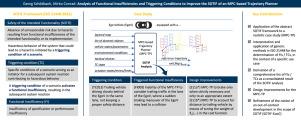分析了基于mpc的轨迹规划器的功能缺陷和触发条件,改进了SOTIF
IF 4.6
2区 计算机科学
Q1 AUTOMATION & CONTROL SYSTEMS
引用次数: 0
摘要
在过去的十年里,自动驾驶技术取得了重大的飞跃。在这个过程中,用于车辆控制的算法的复杂性大大增加。模型预测控制(MPC)就是一个突出的例子,它在车辆运动规划和控制中得到了广泛的应用。然而,安全问题限制了它的实际应用,特别是因为传统的功能安全程序,其通用标准ISO 26262,达到了极限。与此同时,预期功能安全(SOTIF)的新方面已成为关注的中心,其标准ISO 21448仅在2022年发布。然而,SOTIF的经验很少,在工业和研究中很少有案例研究。因此,本文旨在做出两个主要贡献:(1)分析SOTIF,并提供认证指南,用于通用的基于mpc的轨迹规划器;(2)将ISO 21448中描述的通用程序解释和应用于基于研究的案例研究,目的是确定功能不足(fi)和触发条件(tc)。本文的特别新颖之处包括:sotif相关元素(SOTIF-EooC)的非上下文开发方法,用于基于mpc的轨迹规划器的重要fi和tc的汇编,以及基于已识别的fi和tc的基于mpc的轨迹规划器的优化安全概念。本文章由计算机程序翻译,如有差异,请以英文原文为准。

Analysis of functional insufficiencies and triggering conditions to improve the SOTIF of an MPC-based trajectory planner
Automated and autonomous driving has made a significant technological leap over the past decade. In this process, the complexity of algorithms used for vehicle control has grown significantly. Model Predictive Control (MPC) is a prominent example, which has gained enormous popularity and is now widely used for vehicle motion planning and control. However, safety concerns restrict its practical application, especially since traditional procedures of functional safety, with its universal standard ISO 26262, reach their limits. Concomitantly, the new aspect of safety of the intended functionality (SOTIF) has moved into the center of attention, whose standard, ISO 21448, has only been released in 2022. Experience with SOTIF, however, is low and few case studies are available in industry and research. Hence, this paper aims to make two main contributions: (1) an analysis of the SOTIF, with a certification guidance, for a generic MPC-based trajectory planner and (2) an interpretation and application of the generic procedures described in ISO 21448 to a research-based case study, with the goal of determining the functional insufficiencies (FIs) and triggering conditions (TCs). Particular novelties of the paper include an approach for the out-of-context development of SOTIF-related elements (SOTIF-EooC), a compilation of important FIs and TCs for a MPC-based trajectory planner, and an optimized safety concept based on the identified FIs and TCs for the MPC-based trajectory planner.
求助全文
通过发布文献求助,成功后即可免费获取论文全文。
去求助
来源期刊

Control Engineering Practice
工程技术-工程:电子与电气
CiteScore
9.20
自引率
12.20%
发文量
183
审稿时长
44 days
期刊介绍:
Control Engineering Practice strives to meet the needs of industrial practitioners and industrially related academics and researchers. It publishes papers which illustrate the direct application of control theory and its supporting tools in all possible areas of automation. As a result, the journal only contains papers which can be considered to have made significant contributions to the application of advanced control techniques. It is normally expected that practical results should be included, but where simulation only studies are available, it is necessary to demonstrate that the simulation model is representative of a genuine application. Strictly theoretical papers will find a more appropriate home in Control Engineering Practice''s sister publication, Automatica. It is also expected that papers are innovative with respect to the state of the art and are sufficiently detailed for a reader to be able to duplicate the main results of the paper (supplementary material, including datasets, tables, code and any relevant interactive material can be made available and downloaded from the website). The benefits of the presented methods must be made very clear and the new techniques must be compared and contrasted with results obtained using existing methods. Moreover, a thorough analysis of failures that may happen in the design process and implementation can also be part of the paper.
The scope of Control Engineering Practice matches the activities of IFAC.
Papers demonstrating the contribution of automation and control in improving the performance, quality, productivity, sustainability, resource and energy efficiency, and the manageability of systems and processes for the benefit of mankind and are relevant to industrial practitioners are most welcome.
 求助内容:
求助内容: 应助结果提醒方式:
应助结果提醒方式:


